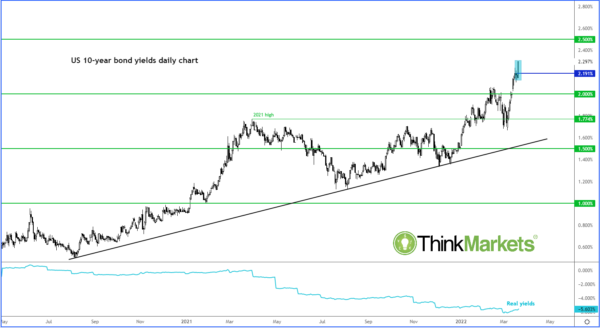Jerome Powell’s latest remarks caused a bit of panic as investors realised that the Fed is open to an even more aggressive rate hiking path. Powell noted that – if necessary – the Fed would be open to raising rates by a more aggressive 50-basis points at any of its upcoming meetings.
Powell said:
We will take the necessary steps to ensure a return to price stability…In particular, if we conclude that it is appropriate to move more aggressively by raising the federal funds rate by more than [a quarter-point] at a meeting or meetings, we will do so.
Following his comments, the major indices took a quick nosedive while the dollar found support and gold eased off its earlier highs, as yields soared. If it does hike by 50 bps, it would be the first time since May 2000 to do that. The Fed has already signalled a much stronger appetite to combat inflation, indicating a further 6 rate increases in 2022. But judging by Powell’s latest comments and those from some of the Fed officials, there is a good possibility that we may even see a 50 basis point increase in May. Let’s see if there is much appetite for that, and what plans they might have for running down the central bank’s $8.9 trillion balance sheet.
Ukraine-Russia uncertainty continues…
While Powell’s remarks have caused a bit of a sell-off in stocks, this comes on the back of a strong rally last week despite continued uncertainty surrounding the Ukraine and Russia.
On that front, no agreements have been reached yet in negotiations with Ukraine. Ukraine’s president has said his country could never surrender Kyiv, Mariupol or Kharkiv to Russia. Russia says there needs to be significant progress made first before a possible meeting between Putin and Zelensky. Last week, hopes over a possible deal had lifted sentiment in the market. Russia’s negotiator on Friday, for example, said that the two sides were now ‘halfway there’ on the issue of Ukraine’s demilitarization, and that on the issues where their views are most-closely aligned is Ukraine’s neutral status and not joining NATO. Let’s see if the gap closes in the days ahead, but it doesn’t look promising.
Still, if you look at the financial markets over the past week or so, it is as if the Ukraine war never happened, or the Fed was not very hawkish. Stock markets roared back higher to close solidly in the black last week. This was the second consecutive weekly positive close for European indices, but the first one for Wall Street and Asia Pacific (APAC) markets. STOXX Europe 600 erased all the losses it had suffered since the invasion of Ukraine began. Risk-sensitive commodity dollars surged higher, while safe-haven Japanese yen and gold slumped. Yen pairs had a wonderful week. Cryptocurrencies traded mostly higher. Crude oil bounced sharply off the lows but still ended lower for the second consecutive week. But that rebound has continued into the new week with Brent reaching $111 and WTI $108 per barrel. Oil prices must be watched closely given ongoing concerns over soaring inflation, as any further sustained pressure will intensify those concerns and potentially have repercussions elsewhere in the financial markets.
Economic data highlights for the rest of the week
In terms of macro data, the highlights include durable goods orders and housing market data. From the UK, we have CPI and retail sales, while in Switzerland, the SNB will be making a “decision” on interest rates. Hint: no rate increases are coming. Another set of key data will be the latest PMI numbers, due on Wednesday from Eurozone.
Tuesday 22 March
- Central bank speech: ECB’s Lagarde, FOMC’ Williams, SNB’s Jordan and MPC’s Cunliffe
- UK spring statement and Consumer Price Index (CPI) for February
- Central bank speech: BoE’s Bailey, FOMC’s Powell and Bullard
- SNB rate decision
- Flash PMIs from France, Germany and UK
- US durable goods orders, jobless claims and flash PMIs
- UK retail sales
- German Ifo













